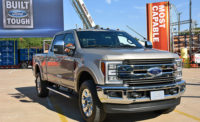Heavy-Duty Truckers Say Goodbye to the Stick
Do you still hear the sound of gears grinding on the jobsite? It soon may be a thing of the past. A trucker’s old friends—the shifter and clutch pedal—are headed toward extinction as drivers discover the benefits of automatic transmissions.

Although more than 80% of domestic heavy-duty trucks are still sold with a manual transmission, experts like David Stahl, sales manager for Pittsburgh-based dealer TransEdge Truck Centers, think it is a matter of time before the stick, a century-old technology, goes away. He says, “Someday you’ll take your children and your grandchildren to the museum, [and] they’ll say, ‘What’s that pedal and that extra shifter in there for?’ ”
Aside from convenience, fuel economy is the main reason why more trucks are going automatic. In the past, manuals typically offered a fuel-efficiency edge over older-style torque-converter automatics, which use hydraulics to shift gears. With newer-style, automated-manual transmissions (AMTs), electronics shift the clutch packs conventionally, offering 1% to 2% better fuel economy.
“It makes the shift at all the optimum times,” Stahl explains, adding that maintenance costs go down because drivers are less apt to abuse the gearbox. AMTs typically cost about $5,000, adding around 4% to 5% more to the truck’s cost.
Clicking Into Place
As the Obama Administration is targeting reductions of up to 20% in greenhouse- gas emissions from heavy trucks by 2018, automatic transmissions are seen as one way to meet that goal. “[Truckers] will often change transmission type to gain a 1% or 2% reduction in fuel consumption, as long as the cost is reasonable and the reliability of the technology is solid,” says the National Research Council.
In addition to efficiency, automatics are becoming a safety tool. New federal safety rules being implemented this year will require commercial carriers to watch drivers’ records more closely. Taking away the stick keeps drivers’ eyes on the road so they “don’t have to do anything,” says Stahl. “You just put it in drive like your car, and the truck goes down the road.”
The shift to automatics also opens up the driver pool because running a truck is now easier, adds Denny Slagle, CEO of Volvo Group’s North American Trucks and Mack Trucks Inc. The new rules will squeeze out poor drivers, “but it’ll create the need for more drivers,” he adds.
Experienced drivers may lament the decline of the stick, which is difficult to master on a tractor with a dozen gears or more. “When I was in traffic school, [shifting] was one of the hardest things [to learn],” says Daryl Ward, 32, a delivery truck driver in Chicago. “Within the next decade, I bet all the trucks are going to be automatic.”
Delivery trucks are ideal candidates for automatics, adds Kenny Vieth, president and senior analyst at ACT Research, Columbus, Ind. “For anybody that’s doing any starting and stopping at all, I think getting out of shifting gears just makes a whole lot of sense,” he says.
Though some truckers prefer the control a manual offers, fleets are warming up quickly to AMTs. Earlier this year, Allentown, Pa.-based Mack rolled out its AMT, called mDRIVE, which promises a 1.5% fuel economy increase over a manual transmission. Expecting to sell 50 this year, it received more than 500 orders.
“I’m living proof that you can be off on your forecast by a factor of 10 and still have a job,” David McKenna, Mack product marketing manager, told clients at a Mack sales conference ENR attended in October. Sweden-based Volvo, Mack’s parent, has sold hundreds of its iSHIFT AMT in North America. In Europe, about 40% of Volvos on the road use it.
Tony Muniz, 39, who drives a concrete mixer in Chicago, is skeptical about the versatility of AMTs for off-road duty. “We go to a lot of jobsites where there is mud. I don’t know how an automatic would handle in that situation,” he says. Muniz adds that an automatic could make city trucking more pleasant, saying, “I think if you are driving downtown, an automatic would be great.”
Although construction trucks have been slower to adopt automatics, they too are expected to go shiftless. “There are some light-construction applications that we are going to be in,” says Stahl. “Eventually, the transmission will move into heavier construction.”






